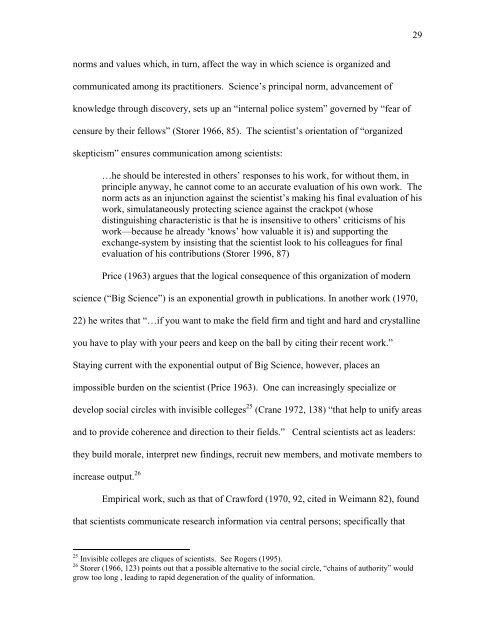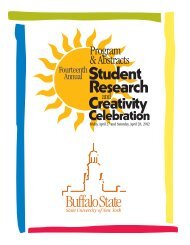POLITICS VERSUS SCIENCE: APPORTIONING ... - Buffalo State
POLITICS VERSUS SCIENCE: APPORTIONING ... - Buffalo State
POLITICS VERSUS SCIENCE: APPORTIONING ... - Buffalo State
You also want an ePaper? Increase the reach of your titles
YUMPU automatically turns print PDFs into web optimized ePapers that Google loves.
norms and values which, in turn, affect the way in which science is organized and<br />
communicated among its practitioners. Science’s principal norm, advancement of<br />
knowledge through discovery, sets up an “internal police system” governed by “fear of<br />
censure by their fellows” (Storer 1966, 85). The scientist’s orientation of “organized<br />
skepticism” ensures communication among scientists:<br />
…he should be interested in others’ responses to his work, for without them, in<br />
principle anyway, he cannot come to an accurate evaluation of his own work. The<br />
norm acts as an injunction against the scientist’s making his final evaluation of his<br />
work, simulataneously protecting science against the crackpot (whose<br />
distinguishing characteristic is that he is insensitive to others’ criticisms of his<br />
work—because he already ‘knows’ how valuable it is) and supporting the<br />
exchange-system by insisting that the scientist look to his colleagues for final<br />
evaluation of his contributions (Storer 1996, 87)<br />
Price (1963) argues that the logical consequence of this organization of modern<br />
science (“Big Science”) is an exponential growth in publications. In another work (1970,<br />
22) he writes that “…if you want to make the field firm and tight and hard and crystalline<br />
you have to play with your peers and keep on the ball by citing their recent work.”<br />
Staying current with the exponential output of Big Science, however, places an<br />
impossible burden on the scientist (Price 1963). One can increasingly specialize or<br />
develop social circles with invisible colleges 25 (Crane 1972, 138) “that help to unify areas<br />
and to provide coherence and direction to their fields.” Central scientists act as leaders:<br />
they build morale, interpret new findings, recruit new members, and motivate members to<br />
increase output. 26<br />
Empirical work, such as that of Crawford (1970, 92, cited in Weimann 82), found<br />
that scientists communicate research information via central persons; specifically that<br />
25 Invisible colleges are cliques of scientists. See Rogers (1995).<br />
26 Storer (1966, 123) points out that a possible alternative to the social circle, “chains of authority” would<br />
grow too long , leading to rapid degeneration of the quality of information.<br />
29












